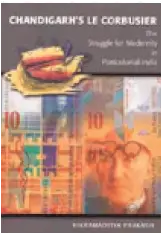When India emerged from colonial rule in 1947, the division of Punjab left its historic capital, Lahore, in newly created Pakistan. Indian Prime Minister Jawaharlal Nehru insisted that Punjab’s new capital, Chandigarh, should be a symbol of the nation’s faith in the future, free from the traditions of the past. Its design and construction became a matter of national attention, and Le Corbusier, the icon of European architectural modernism, was invited to help remake India’s national ideal.
Le Corbusier’s real name was Charles Edouard Jeanne ret. He completely dropped his name after the year 1929. Le Corbusier arrived in 1950, in the twilight of his career. He set to work alternately wooing and clashing with Nehru and with the Indian planners and builders, prevailing ultimately only in the design of the Capitol Complex and a few buildings in the Museum Complex, as well as in his lasting symbol of peace and nonalignment, the Open Hand.
Vikramaditya Prakash tells the fascinating story that lies behind the planning and architecture of Chandigarh. Drawing on his intimate knowledge of the city, where he grew up as the son of one of the nine Indian architects who assisted in designing Chandigarh, Prakash brings to light stories of town planners, bureaucrats, and architects vying over the colonial past and the symbolic future of India .In one such story he talks about how Le Corbusier taught his father to design the School of Art sitting on a stool and his father was drawing on the blackboard.
The city’s first architect planners Albert Mayer and Matthew Nowicki were handed a brief but later the brief was handed over to Pierre Jeanne ret, Maxwell Fry and Jane Dew after the death of Matthew Nowicki in the year 1950. P. Jeanne ret was Corbusier’s cousin and had been bought into the project as the resident architect because of Le Corbusier’s prior commitments.
Of all the architects however Le Corbusier’s name is most famously associated with Chandigarh. He was one of the icons of utopian modernism and was embodied with the image of a Hero architect battling against the fortresses of old, forging a brave new world, whatever being the odds.
Different conceptions of the modern and the role of Indian civilization clashed and coalesced in a process that highlights the mutual interdependence of “East” and “West,” and the fact that architecture and aesthetics cannot be separated from ideological claims and political implications.
The book follows a simple hierarchical order, diminishing in scale by chapters. It begins with the design of the overall Master plan of Chandigarh followed by two chapters on design of the Le Corbusier’s main buildings and the last chapter is about the discussion of the city’s emblem “The Open Hand”.
Chapter 2 engages the question of Chandigarh’s modernism and tells the tale of the mirrored misrecognitions that set the stage for Chandigarh’s development.
Chapter 3 undertakes an interpretation of the Capitol complex. The chapter is motivated by the search not for Le Corbusier’s formal design precedents, but for his perception and representation of India.
Chapter 4 constitutes a psychoanalytic reading of the Capitol buildings, this chapter also engages in a reading of the aesthetic construction of the High Court and the Assembly. These readings suggest ways in which memories from Le Corbusier’s distant past, along with the impressions of his tenure in India, were woven into aesthetic compositions of the capitol buildings.
Chapter 5 offers interpretations of the Open Hand and the reason for it being constructed in the 1980 and not with the rest of the Capitol Complex. It was an emblem not only for Chandigarh but also for the foundation for the preservation and the propagation of the Le Corbusier’s archives.
Prakash skillfully unfolds the intricate layers of the Capitol’s symbolism, tracing the cultural preconceptions and influences that produced Le Corbusier’s understanding of India and animated his obsessions, desires, and aspirations. Chandigarh’s Le Corbusier is the story of the making of an Indian modern architecture as both an aspect and an engine of post-colonial culture.
This book review was written by: Annkit Kummar


Leave a Reply
You must be logged in to post a comment.